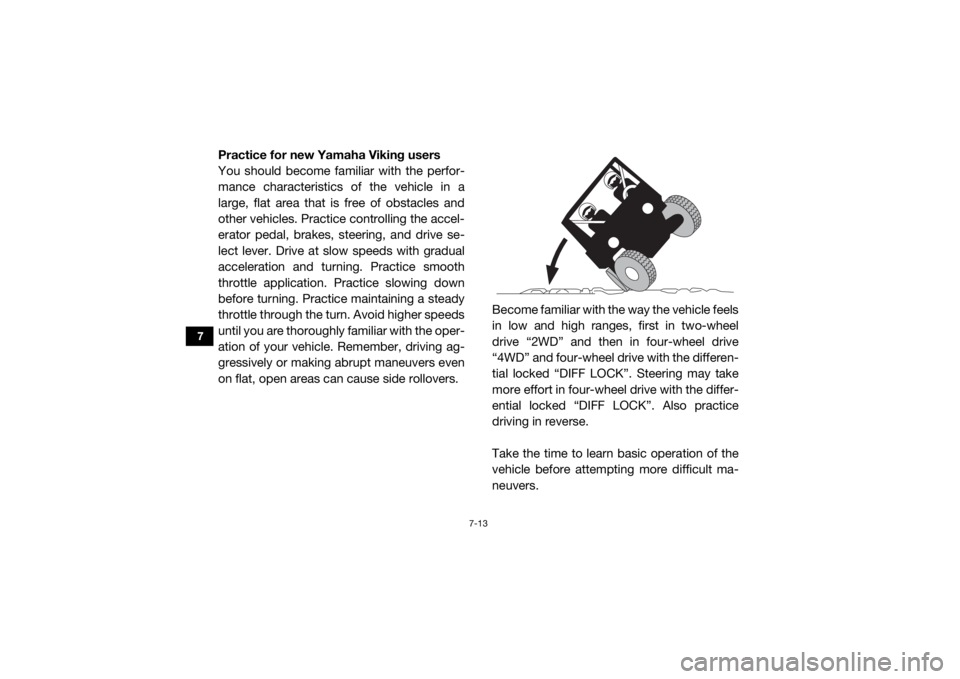Page 37 of 172
4-2
4
EBU31260Indicator lights and warning lights
EBU31270Low-range indicator light “L”
This indicator light comes on when the drive
select lever is in the “L” position.EBU31280High-range indicator light “H”
This indicator light co mes on when the drive
select lever is in the “H” position.
1. On-Command differential gear lock indicator light “DIFF.
LOCK”
2. Low-range indicator light “L”
3. High-range indicator light “H”
4. Neutral indicator light “N”
5. Reverse indicator light “R”
6. Parking brake indicator light “ ”
7. On-Command four-wheel-drive/differential gear lock indicator “ ”/“ ”
8. Engine trouble warning light “ ”
9. Coolant temperature warning light “ ”
10.Electric Power Steering warning light “EPS”356421
7
8109
1. Helmet indicator light “ ”
2. Seat belt indicator light “ ”
21
UB427AE0.book Page 2 Monday, May 18, 2015 9:17 AM
Page 38 of 172

4-3
4
EBU31290Neutral indicator light “N”
This indicator light comes on when the drive
select lever is in the “N” position.EBU31300Reverse indicator light “R”
This indicator light comes on when the drive
select lever is in the “R” position.EBU31310Parking brake indicator light “ ”
This indicator light comes on when the park-
ing brake is applied.EBU31320On-Command four-wheel-drive
indicator “ ”, On-Command differential
gear lock indicator “ ” and indicator light
“DIFF. LOCK”
The On-Command four-wheel-drive
indicator “ ” comes on when the On-Com-
mand drive knob “2WD/4WD/DIFF LOCK” is
set to the “4WD” position.The On-Command differential gear lock
indicator “ ” and the On-Command differen-
tial gear lock indicator light “DIFF. LOCK”
come on when the On-Command drive knob
“2WD/4WD/DIFF LOCK” is set to the “DIFF
LOCK” position.
TIP
Due to the synchronizing mechanism in the
differential gear case, the four-wheel-drive
indicator may not come on until the vehicle
starts moving.
When the On-Command drive knob
“2WD/4WD/DIFF LOCK” is set to “DIFF
LOCK” or “4WD”, the indicator “ ” and the
indicator light “DIFF. LOCK” will flash until
the differential gear is completely locked or
unlocked. If the indicator and the indicator
light continue to flash, the differential is not
completely locked or unlocked. In this
case, start moving to allow time for the dif-
ferential to lock or unlock.
UB427AE0.book Page 3 Monday, May 18, 2015 9:17 AM
Page 46 of 172
4-11
4
Set the switch to “ ” to turn off the head-
lights and taillights.NOTICEECB02060Do not use the headlights with the engine
turned off for an extended period of time.
The battery may discharge to the point
that the starter motor will not operate
properly. If this should happen, remove the
battery and recharge it.
EBU31400On-Command drive knob
“2WD/4WD/DIFF LOCK”This vehicle is equipped with an On-Com-
mand drive knob to select the drive mode.
The knob has three positions: “2WD”, “4WD”,
and “DIFF LOCK”. Select the appropriate
drive according to terrain and conditions.
“2WD” (two-wheel drive): Power is supplied
to the rear wheels only.
“4WD” (four-wheel drive): Power is sup-
plied to the rear and front wheels.1. On-Command drive knob “2WD/4WD/DIFF LOCK”
1
UB427AE0.book Page 11 Monday, May 18, 2015 9:17 AM
Page 47 of 172
4-12
4
“DIFF LOCK” (four-wheel drive with the dif-
ferential gear locked): Power is supplied to
the rear and front wheels with the differen-
tial gear locked. Unlike the “4WD” mode, all
wheels turn at the same speed regardless
of traction.EBU33192Horn switch “ ”Press the switch to sound the horn.
EBU31410Accelerator pedalPress the accelerator pedal down to increase
engine speed. Spring tension returns the ped-
al to the rest position when released. Always
check that the accelerator pedal returns nor-
mally before starting the engine.EBU31420Brake pedalPress the brake pedal to slow or stop the ve-
hicle.
1. Horn switch “ ”
1
1. Accelerator pedal
1
UB427AE0.book Page 12 Monday, May 18, 2015 9:17 AM
Page 75 of 172
6-5
6
EBU31921On-Command drive knobThe vehicle handles differently in each of the drive modes (“2WD”, “4WD” and “DIFF LOCK”). For
example, the vehicle requires more effort to turn in “DIFF LOCK” than in “2WD”. Always stop the
vehicle before changing the position of the On -Command drive knob. The meter display changes
according to the selected drive mode. The different drive indicators, and the differential gear lock
indicator light “DIFF. LOCK” come on as follows:
Knob position Indication Drive mode
No indicator light.
“2WD” (two-wheel drive): Power is supplied to the rear
wheels.
“4WD” (four-wheel drive): Power is supplied to the rear and
front wheels.
“DIFF LOCK” (four-wheel drive with the differential gear
locked): Power is supplied to the rear and front wheels and
the differential gear is locked.
Unlike in four-wheel drive, all wheels turn at the same
speed.
UB427AE0.book Page 5 Monday, May 18, 2015 9:17 AM
Page 92 of 172

7-13
7
Practice for new Yamaha Viking users
You should become familiar with the perfor-
mance characteristics of the vehicle in a
large, flat area that is free of obstacles and
other vehicles. Practice controlling the accel-
erator pedal, brakes, steering, and drive se-
lect lever. Drive at slow speeds with gradual
acceleration and turning. Practice smooth
throttle application. Practice slowing down
before turning. Practice maintaining a steady
throttle through the turn. Avoid higher speeds
until you are thoroughly familiar with the oper-
ation of your vehicle. Remember, driving ag-
gressively or making abrupt maneuvers even
on flat, open areas can cause side rollovers.Become familiar with the way the vehicle feels
in low and high ranges, first in two-wheel
drive “2WD” and then in four-wheel drive
“4WD” and four-wheel drive with the differen-
tial locked “DIFF LOCK”. Steering may take
more effort in four-wheel drive with the differ-
ential locked “DIFF LOCK”. Also practice
driving in reverse.
Take the time to learn basic operation of the
vehicle before attempting more difficult ma-
neuvers.UB427AE0.book Page 13 Monday, May 18, 2015 9:17 AM
Page 94 of 172

7-15
7
Avoid higher speeds and sudden or hard ac-
celeration until you are thoroughly familiar
with the operation of your vehicle. Avoid sud-
den or hard acceleration in any turn.
Braking
When slowing down or stopping, take your
foot off the accelerator pedal and press the
brake pedal smoothly. Improper use of the
brakes can cause the tires to lose traction, re-
ducing control of the vehicle and increasing
the possibility of an accident.
Braking ability is affected by type of terrain. In
most cases, gradual application of the brakes
is more effective than abrupt braking, partic-
ularly on loose surfaces, such as gravel. Al-
ways allow for greater braking distance on
rough, loose, or slippery surfaces.
Engine braking
Engine compression braking is designed to
assist you when operating your Viking off-
road. With this feature, the engine helps slow the vehicle down after you take your foot off
the accelerator. Engine braking is more no-
ticeable in four-wheel drive. Application of ve-
hicle brakes provides additional stopping
power.
Leaving the vehicle
Do not get out of the vehicle while the engine
is running and the drive select lever is in any
gear. There is a risk
of injury because:
Children or others may accidentally press
the accelerator pedal.
Objects tossed into the vehicle may strike
the accelerator pedal.
The parking brake may not keep the vehicle
from accelerating.
Unwanted vehicle movement can cause seri-
ous injury or death, and it may be dangerous
to try to stop the vehicle.UB427AE0.book Page 15 Monday, May 18, 2015 9:17 AM
Page 95 of 172

7-16
7
Parking on a flat area
When parking on a flat area, stop the engine
and shift the drive select lever into the neutral
position. Apply the parking brake to help pre-
vent the vehicle from rolling.
Parking on a slope
The parking brake acts only on the rear
wheels when in “2WD”. For the parking brake
to take effect on all four wheels, shift to “DIFF
LOCK” before stopping the engine.
If you park on a hill that is too steep the vehi-
cle may roll out of control. Never park on hills
that are so steep you cannot walk up them
easily. If you must park on an incline follow
these instructions:1. Bring the vehicle to a stop by applying the brake pedal.
2. Put the vehicle in “DIFF LOCK”.
3. Turn the key to “ ” (off).
4. With the brake pedal applied, set the parking brake. 5. Block the front and rear wheels with
rocks or other objects.
Loading
The total weight of operator, passengers, ac-
cessories, cargo, trailer tongue weight, and
the vehicle itself must not exceed 1080 kg
(2381 lb). Vehicle loading can affect handling.
See “Loading” on page 6-7.
EBU33360Operation on different surfaces and
terrainsGo slowly and proceed with caution when op-
erating on an unfamiliar surface or terrain.
This vehicle may handle differently in certain
types of terrains or on certain surfaces. You
may come upon hidden rocks, bumps, or
holes without enough time to react. To avoid
loss of control or rollover, always be alert to
changing surfaces or terrain when operating
the vehicle.
UB427AE0.book Page 16 Monday, May 18, 2015 9:17 AM